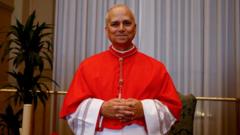As cardinals deliberate the future of the Catholic Church, black smoke signals uncertainty after the first ballot, leading to heightened anticipation among the faithful gathered in St. Peter’s Square.
Anticipation Builds as Cardinals Convene for Papal Election

Anticipation Builds as Cardinals Convene for Papal Election
The conclave to elect a new pope continues, with crowds growing outside Vatican City following the inconclusive first ballot.
The atmosphere in Vatican City thickened with anticipation as crowds gathered in St. Peter's Square, awaiting the outcome of the conclave to elect the next pope. Following a first inconclusive ballot, which ended with black smoke billowing from the Sistine Chapel just before noon, excitement and hope surged among onlookers.
This conclave marks the largest gathering of cardinals to date, as they grapple with the urgent task of selecting a successor to Pope Francis, who passed away in April. Many of the cardinals, appointed by Francis during his 12-year pontificate, are now meeting one another for the first time, adding a layer of complexity to the deliberations.
The mood in the square—a melting pot of diverse onlookers, including nuns, priests, and tourists—reflects the anticipation reminiscent of previous conclaves, where voters have historically faced pressure to quickly reach a consensus. In light of Francis' progressive legacy, the selection process comes with considerable stakes, as ideological divisions among cardinals have emerged, especially regarding issues of inclusion and doctrinal conservatism.
During the conclave, which resumes with multiple daily voting rounds until a two-thirds majority is reached, the cardinals will burn ballots to signal their decision with smoke. The ritual of awaiting white smoke has become a symbol of hope for millions of faithful Catholics worldwide, as they seek a leader who can unify the church’s varied factions.
As the day unfolds, the world watches, wondering whether the divinely inspired decision will signal a continuation of Francis’ inclusive vision or a shift toward traditionalist values, marking a pivotal moment in modern Catholic history.
This conclave marks the largest gathering of cardinals to date, as they grapple with the urgent task of selecting a successor to Pope Francis, who passed away in April. Many of the cardinals, appointed by Francis during his 12-year pontificate, are now meeting one another for the first time, adding a layer of complexity to the deliberations.
The mood in the square—a melting pot of diverse onlookers, including nuns, priests, and tourists—reflects the anticipation reminiscent of previous conclaves, where voters have historically faced pressure to quickly reach a consensus. In light of Francis' progressive legacy, the selection process comes with considerable stakes, as ideological divisions among cardinals have emerged, especially regarding issues of inclusion and doctrinal conservatism.
During the conclave, which resumes with multiple daily voting rounds until a two-thirds majority is reached, the cardinals will burn ballots to signal their decision with smoke. The ritual of awaiting white smoke has become a symbol of hope for millions of faithful Catholics worldwide, as they seek a leader who can unify the church’s varied factions.
As the day unfolds, the world watches, wondering whether the divinely inspired decision will signal a continuation of Francis’ inclusive vision or a shift toward traditionalist values, marking a pivotal moment in modern Catholic history.























